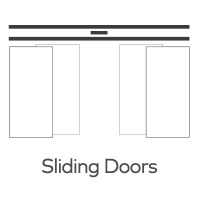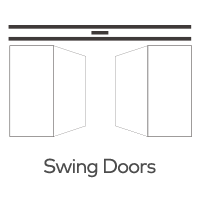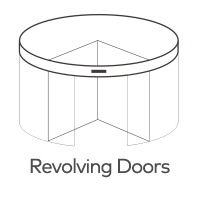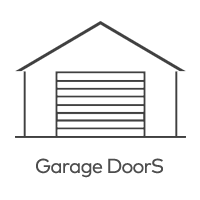Les capteurs laser réduisent-ils la consommation d'énergie des portes battantes automatiques ?
Les portes battantes automatiques sont couramment utilisées dans les bâtiments commerciaux, les aéroports, les hôpitaux, les centres commerciaux et d'autres zones à haut trafic, offrant commodité et accessibilité. Cependant, un défi avec les portes automatiques est leur consommation d’énergie. Ces portes sont souvent en fonctionnement tout au long de la journée, et l'ouverture et la fermeture constantes peuvent entraîner une perte d'énergie importante, en particulier dans les climats à températures extrêmes.
3. Optimisation des temps d'ouverture et de fermeture des portes
Une autre caractéristique d'économie d'énergie des capteurs laser est leur capacité à optimiser la durée de la porte qui reste ouverte. Les portes automatiques traditionnelles restent souvent ouvertes pendant une période déterminée une fois déclenchées, peu importe si quelqu'un passe encore ou si le chemin est clair. Pendant ce temps, l'énergie continue de se perdre à travers la porte ouverte. Les capteurs laser aident à optimiser cela en mesurant la présence d’objets ou de personnes dans le chemin de la porte. Une fois que le capteur détecte que personne n'est présent ou que l'objet est passé, il peut rapidement déclencher la porte pour se fermer, s'assurant qu'elle ne reste pas ouverte plus longtemps que nécessaire. Ce temps de réponse rapide garantit que le temps d’ouverture de la porte est minimisé, réduisant ainsi le gaspillage d’énergie. Dans les environnements où les gens vont et viennent fréquemment, comme les centres commerciaux ou les bâtiments de bureaux, les capteurs laser peuvent améliorer considérablement l'efficacité énergétique en limitant le temps d'ouverture de la porte au moment nécessaire.
4. Réduction des pertes de chauffage et de refroidissement
L'une des économies d'énergie les plus significatives réalisées par les capteurs laser est la réduction des pertes de chauffage et de refroidissement. Lorsqu'une porte automatique s'ouvre, l'air conditionné de l'intérieur du bâtiment s'échappe et l'air extérieur - chaud ou froid - pénètre dans le bâtiment. Cela peut imposer une pression sur les systèmes de climatisation et conduire à des coûts énergétiques plus élevés. Par exemple, dans un climat froid, si la porte s'ouvre fréquemment et reste ouverte pendant de longues périodes, l'air froid de l'extérieur peut réduire considérablement la température intérieure, ce qui fait que le système HVAC travaille plus dur pour maintenir un environnement confortable. Il en va de même dans les climats chauds, où les portes ouvertes peuvent laisser entrer de l’air chaud, forçant la climatisation à travailler des heures supplémentaires. En réduisant les ouvertures inutiles et en veillant à ce que la porte se ferme rapidement lorsque la zone est claire, les capteurs laser minimisent ces fluctuations de température, réduisant la quantité d'énergie nécessaire pour maintenir le confort intérieur. En effet, les capteurs laser contribuent à créer un environnement intérieur plus stable en veillant à ce que les portes ne s'ouvrent que lorsque cela est nécessaire, réduisant ainsi la pression sur les systèmes de climatisation et d'économie d'énergie. Économies d'énergie dans les zones à haut trafic
Les zones à haut trafic, telles que les aéroports, les hôpitaux et les centres commerciaux, sont les endroits où les portes automatiques sont les plus couramment utilisées. Ces endroits connaissent généralement des cycles de porte fréquents, où la porte s’ouvre et se ferme plusieurs fois par minute. Plus une porte fonctionne fréquemment, plus le potentiel de perte d'énergie est élevé. Les capteurs laser sont particulièrement efficaces dans ces environnements à forte fréquentation car ils assurent un contrôle précis de l'ouverture et de la fermeture de la porte. Ils veillent à ce que la porte ne s'ouvre que lorsque cela est nécessaire et empêchent la porte de rester ouverte pendant de longues périodes pendant les berceaux dans la circulation piétonne. Par exemple:
- Dans un aéroport, lorsque de grands groupes de passagers traversent constamment, le capteur laser s'assure que les portes ne s'ouvrent que lorsque les gens s'approchent directement, empêchant ainsi les ouvertures inutiles lorsque les gens passent. Dans un hôpital où un contrôle précis est nécessaire pour éviter les perturbations de la climatisation, les capteurs laser veillent à ce que la porte ne s'ouvre que lorsque cela est nécessaire, minimisant ainsi le risque de perte d'énergie lorsqu'il y a des pauses entre les mouvements du patient ou du personnel. En réduisant les mouvements inutiles de la porte, les capteurs laser aident à réduire le nombre total de cycles de porte, ce qui se traduit directement par une consommation énergétique plus faible au fil du temps.
6. Économies d'énergie à long terme et retour sur investissement
Bien que les capteurs laser comportent un coût initial pour l'installation, les économies d'énergie qu'ils offrent peuvent entraîner un retour sur investissement (ROI) important à long terme. Le coût initial d'installation de capteurs laser peut être compensé par la réduction des coûts énergétiques en raison de:
- Moins de cycles de porte, ce qui entraîne une consommation d'énergie moindre par les systèmes HVAC.
- Réduction des pertes de chauffage et de refroidissement, amélioration de l'efficacité énergétique globale du bâtiment. Un bâtiment plus efficace qui ne consomme de l'énergie que lorsque cela est nécessaire, ce qui est particulièrement précieux dans les grands espaces commerciaux ou les bâtiments à forte circulation piétonne. Les bâtiments dotés de portes basculantes automatiques équipées de capteurs laser peuvent réduire leurs factures énergétiques, ce qui entraîne souvent des économies qui compensent le coût initial de l'installation de capteurs au cours de quelques années.
7. Conclusion
Les capteurs laser peuvent réduire considérablement la consommation d'énergie des portes basculantes automatiques en minimisant les ouvertures inutiles des portes, en optimisant les temps d'ouverture et de fermeture des portes et en réduisant les pertes de chauffage et de refroidissement. Dans les zones fréquentées, ces capteurs sont particulièrement efficaces pour garantir que les portes ne fonctionnent que lorsque cela est nécessaire, évitant le gaspillage d'énergie et maintenant un climat intérieur stable. Bien que l'investissement initial dans les capteurs laser puisse être plus élevé que les capteurs de mouvement traditionnels, les économies d'énergie à long terme en font un excellent choix pour les entreprises, les installations publiques et tout environnement à haut trafic qui cherchent à améliorer l'efficacité et à réduire les coûts opérationnels. En investissant dans la technologie des capteurs laser, les gestionnaires et propriétaires de bâtiments peuvent créer un espace plus durable et économe en énergie, en profitant à la fois du résultat et de l'environnement.







